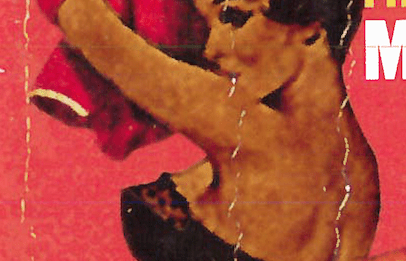Queer life has changed radically in the 25 years since Inside Out was born: non-discrimination laws and marriage equality have been enacted in Canada and around the world; HIV has moved from a death sentence to a manageable condition; and in the entertainment world, we’ve moved from Ellen Degeneres’ post-coming-out show cancellation to gay characters appearing regularly on big and small screens everywhere.
As the film festival celebrates a quarter century, we look back at the turning points and triumphs of one of the Canada’s most important queer institutions.
1991

A collective of filmmakers, arts administrators and activists unite around disparate political and cultural agendas to produce the festival’s first edition. While queer cinema is beginning to scratch at the mainstream’s door with films like My Own Private Idaho and Derek Jarman’s Edward II, the team sees the need to showcase experimental and DIY work. As many as 4,000 people cram into the tiny Euclid Theatre (now a Starbucks at College and Euclid) for 10 days of film not seen anywhere else.
1992

The festival’s second edition launches at the Queen West sleaze palace Boom Boom Room. Queer cinephiles come together to screen works by Sky Gilbert, Steve Reinke, Sadie Benning and Annie Sprinkle, as well as two of Bruce LaBruce’s earliest works, No Skin Off My Ass and Slam.
1993
The City of Toronto pulls a $4,000 grant when council objects to the inclusion of the word “fuck” in the festival program. The community unites to keep things afloat through donations. The series closes with Positive, a program of shorts about the experiences of people living with HIV.
1994

The year opens with a fat, middle finger extended to Hogtown’s conservative politicians, calling their decision out as a “license to promote hate.”
Prominent films include: Mike Hoolboom’s Frank’s Cock, Daniel MacIvor’s I am a Man But and an early work by powerhouse art-dyke duo Shawna Dempsey and Lorri Millan,What Does a Lesbian Look Like?
1995
After four years of volunteers working from home, the festival gets an office and an executive director, Joanne Cormack. Highlights include Christina Zeidler’s Soul Sucka, Suzy Richter’s Old Butch and Nancy Nicol’s doc Gay Pride and Prejudice, a multi-projector work showing Pride and the House of Commons debates around Bill 167 (the Equality Rights Statute Law Amendment) on duelling screens. Derek Jarman’s posthumously released work Glitterbug also receives a rare screening.
1996
Cormack steps down and Elle Flanders takes her place, fresh from a curatorial internship at the Whitney. She aims to re-conceive the festival differently in terms of both finances and how it treats artists. Having spent several years in New York, she’d observed the American funding model of private donors and sponsors. She also emerged from a previous experience with the festival, hopping mad after the only print of her first film caught fire and no one took responsibility. Notable works include punk rock, artfag extraordinaire Scott Treleaven’s Sack Head and two early shorts by a pre-Hanging Garden Thom Fitzgerald: Cherries and Canada Uncut.
1997

The festival departs its dingy College Street digs for the posh Cumberland Cinemas in Yorkville, seen by some as a move away from its roots. The year opens with the film version of Broadway smash Love! Valour! Compassion! Short highlights include Roy Mitchell’s Delta Don, about a lovelorn fag scouring truck stops for a former one-night stand, and a pair of Allyson Mitchell films: Don’t Bug Me and My Very Own After School Special. It also marks the premiere of Streisand spawn Jason Gould’s semi-autobiographical short (coincidentally also named Inside Out).
1998
The same year Will and Grace hits the air, the fest opens with We’re Funny That Way, David Adkin’s doc about Canada’s first gay comedy festival. Experimental shorts by Will Munro, Mirha-Soleil Ross, and Miranda July screen along side Lisa Cholodenko’s seminal lesbian love story High Art. Box-office returns more than double the previous years’ revenues.
1999
As Elle Flanders wraps up her tenure, Shane Smith steps in as program coordinator after previously serving as operations manager. Hits include classic Canadian lesbian rom-com Better Than Chocolate and Steve Yeager’s look at John Waters’ diva Divine Trash. The long-running Queer Youth Digital Video Project has its first incarnation.
2000

Rachel Giese serves one year as the festival’s head honcho. Films include Gerald Hannon’s homemade erotica Cousin Mike, Fenton Bailey and Randy Barbato’s The Eyes of Tammy Faye, and Enza Supermodel, a look at the trans activist’s recent run for mayor.
2001
ED Scott Ferguson has his first year on the job after leaving his position as chair of Pride. Programmer Kathleen Mullen also joins the team. John Cameron Mitchell’s Hedwig opens the fest. At the same time, the US version of Queer As Folk hits the airwaves (with Toronto standing in for Pittsburgh), marking a seminal shift in mainstream portrayals of gay identity.
2002
The festival launches the Mark S Bonham Scholarship for queer post-secondary students studying film, with inaugural winner Adam Garnet Jones taking the prize. Richard Glatzer and Wash West’s dick-in-cheek, coming-of-age comedy The Fluffer has audiences in stitches. Local queens Michelle Ross, Chris Edwards and Stephanie Stevens shine in Edimburgo Cabrera’s doc Divas: Love Me Forever.
2003
The fest turns its attention to France for its first International Focus. The Cruiseline Award for Best Male Short is renamed for celebrated artist Colin Campbell who’d died two years earlier. Leaving Metropolis, Brad Fraser’s adaptation of his hit play Poor Superman, opens the program. Also in the line-up are a retrospective of recently deceased media artist Michael Balser and Benny Nemerofsky Ramsay’s international festival sensation I am a Boyband.
2004

As Inside Out closes in on its 15th year, the organization has an identity shift, seeing itself as a platform that orchestrates multiple programs with the festival being just one component. India gets the International Focus. Craig H Highberger’s Jackie Curtis doc Superstar in a Housedress and John Palmer’s virginity-losing drama Sugar make waves. Also on the cherry-popping front, the Video Virgins program sees artists take the plunge into making their first films, among them Clinton Walker and Kevin Hegge.
2005
As Brokeback Mountain breaks box-office records, queer cinema goes through an existential shift. The German Focus program features teen rower romance Summer Storm, and the Klaus Nomi doc The Nomi Song. Pow! Wow! features shorts by Aboriginal artists and The Man: Peter Berlin profiles the legendarily well-endowed sex symbol.
2006
As Kathleen Mullen steps down, Regina-native Gary Varro takes the reins for a single year. The Latin American focus includes two programs organized by local artist Eugenio Salas, and series by guest curator Suzy Capo from MIX Brazil. Matt Thomas’s Back Alley Jukebox series serves up music videos by queer artists. The festival closes with Spanish director Ramón Salazar’s 20 Centimetres, a film about a narcoleptic pre-op transsexual with an (unfortunately) large endowment.
2007
Jason St-Laurent departs Ottawa’s SAW Gallery to fill the programmer position as Varro is forced to return to the Prairies for family reasons. The program opens with Duncan Roy’s adaptation of The Picture of Dorian Gray. Karen Silverwoman’s short, Hello, My Name is Herman, premieres as part of the Youth Project before sweeping festivals around the world. The first annual Ottawa LGBT Film Festival launches, featuring a selection of works from the Toronto program. Four years of careful financial stewardship and increased donations finally clear an accumulated $60,000 deficit.
2008

All eyes turn Down Under as the focus on Australia brings all things Aussie to the forefront, including a retro screening of Priscilla, Queen of the Desert. The Youth Project turns 10, and produces Gabrielle Zilkha’s hit The Check-Up in the process. Benny Nemerofsky Ramsay receives a festival retrospective. Other faves include Parvez Sharma’s queer Muslim doc A Jihad for Love, and Lucía Puenzo’s Cannes Festival Grand Prix winner XXY, about the life of an intersex teen.
2009
France ends up in the spotlight again, including Vincent Garenq’s Baby Love, about a gay couple who decide to get pregnant. Political docs including John Greyson’s Fig Trees (following HIV activists Tim McCaskell and Zackie Achmat) and Barbara Caspar’s Who’s Afraid of Kathy Acker? draw crowds, along with the archival program of button-pushing shorts Dykes on the Verge of a Nervous Breakdown.
2010

The 20th year opens with James Franco in Howl. The retro screening series includes seminal films The Celluloid Closet, Lilies and Todd Haynes’s Poison. A program of works by American wunderkind Ryan Trecartin screens at Buddies. The Youth Project becomes the Legacy Project, bringing youth and seniors together. The Joan Rivers doc A Piece of Work, by directors Annie Sundberg and Ricki Stern, looks past the surgery to see what makes the pioneering comedian and gay icon tick.
2011
Jason St-Laurent marks his last year as programmer as the festival relocates to the newly built TIFF Bell Lightbox. Le Tigre doc Who Took the Bomp? and sci-fi comedy Codependent Lesbian Space Alien Seeks Same bring crowds. The series 24 Hours in the Middle East includes shorts, features and docs that look at queer life in that part of the world. The festival closes with the BBC-produced adaptation of Sarah Waters’ lesbian WWII drama The Night Watch.
2012

Programmer Andrew Murphy departs his native Halifix to join the team. The International Focus turns its eye on the Nordic countries. Docs blow up big, including Kevin Hegge’s She Said Boom: The Story of Fifth Column, Jim Hubbard’s United in Anger: A History of ACT UP and Jeffrey Schwarz’s look at Vito Russo, the man behind The Celluloid Closet.
2013
Peaches Does Herself charts the journey of the Berlin-based provocateur from bedroom wannabe to full-fledged rock star. Brazil’s Bruno Barreto has a smash hit with Reaching for the Moon, chronicling the affair between poet Elizabeth Bishop and architect Lota de Macedo Soares. And as the new pope dons the sacred robes, Polish film In the Name Of tells the story of one priest’s battle with faith, addiction and sexuality.
2014
The festival’s most recent incarnation features the premiere of Ryan Murphy’s adaptation of The Normal Heart. Ben Cotner and Ryan White’s marriage equality are centre stage in The Case Against 8 and Ira Sachs follows the drama about a gay couple in their 39th year with Love is Strange. As audience attendance climbs and mainstream portrayals of queers grow, the festival history becomes something of a lesson in just how far we’ve come.
All images credited to Inside Out


 Why you can trust Xtra
Why you can trust Xtra


